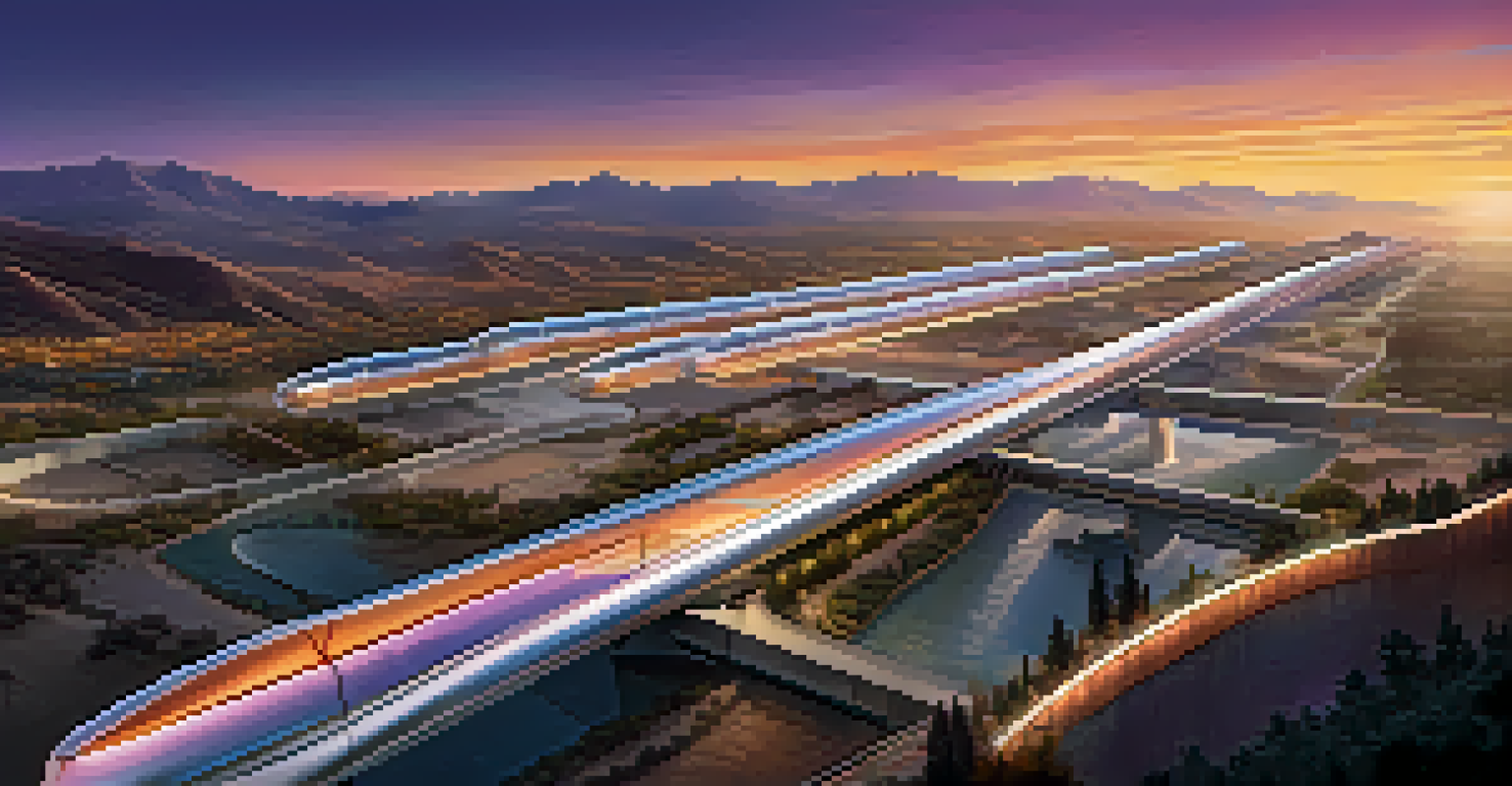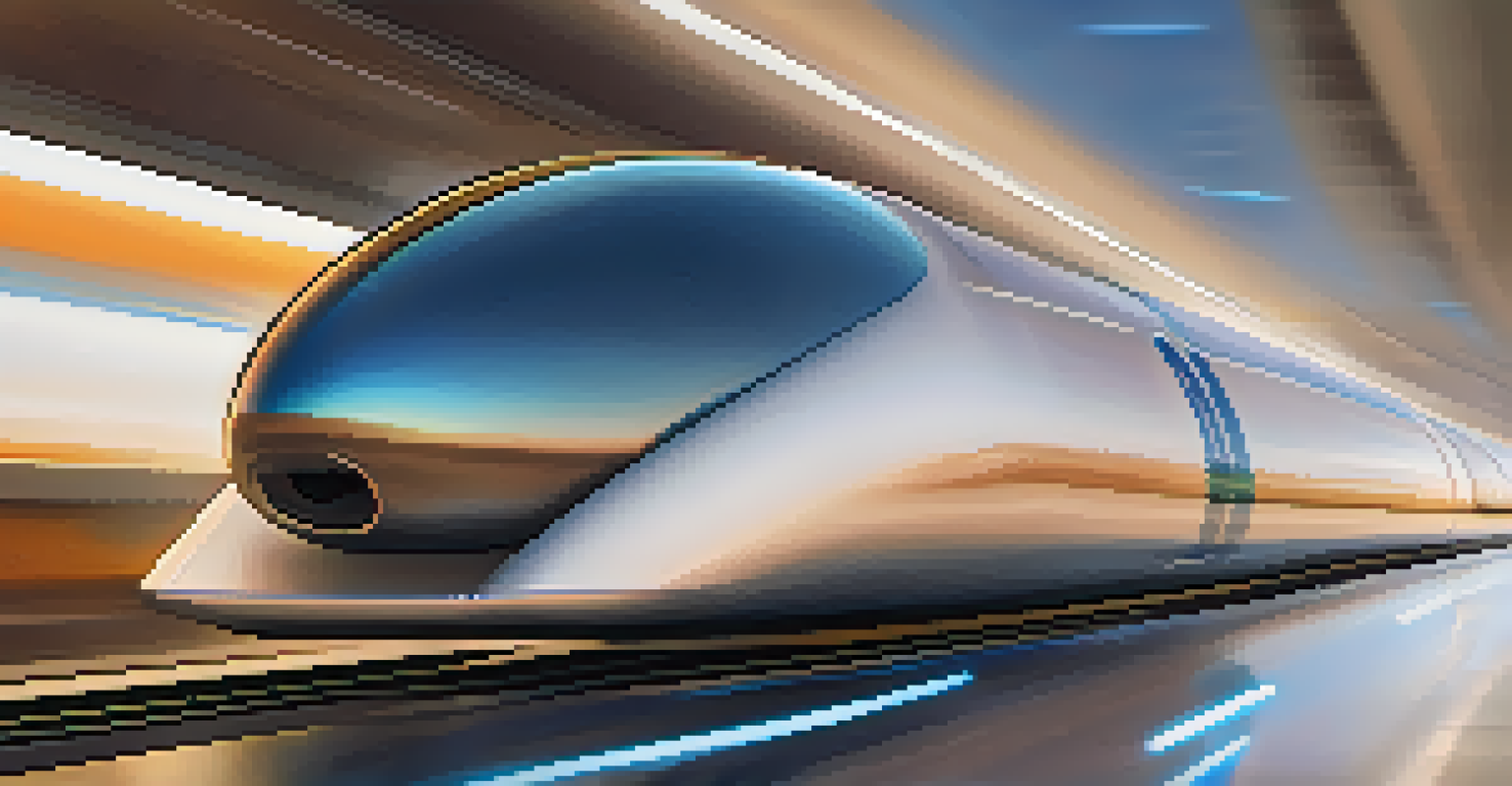Hyperloop Concepts: Transforming Long-Distance Transportation

What is Hyperloop and How Does it Work?
Hyperloop is an innovative transportation concept that envisions pods traveling at high speeds through low-pressure tubes. Imagine a train, but instead of tracks, it glides through a vacuum, reducing air resistance significantly. This technology aims to achieve speeds of over 700 miles per hour, making long-distance travel faster than ever before.
The best way to predict the future is to invent it.
The system operates using magnetic levitation, which allows the pods to float above the track, eliminating friction and enhancing speed. By utilizing solar panels on the tube's surface, Hyperloop also aims to be energy-efficient and environmentally friendly. This combination of speed and sustainability is what makes the Hyperloop concept so exciting for the future of transportation.
Though still in the development stage, several companies, including Virgin Hyperloop and Elon Musk's The Boring Company, are actively working to bring this vision to life. As we explore the potential of Hyperloop, it's essential to understand the implications this technology could have on global travel.
The Advantages of Hyperloop Over Traditional Transport
One of the most significant advantages of Hyperloop is its speed. Compared to airplanes and trains, Hyperloop promises quicker travel times, making it possible to cover distances that used to take hours in mere minutes. This could revolutionize daily commutes and business travel, enhancing productivity and connectivity.

Additionally, Hyperloop is designed to be more energy-efficient than traditional transport methods. With minimal energy required for operation, it could reduce the overall carbon footprint associated with long-distance travel. This aspect is particularly appealing in an era where sustainability is becoming increasingly important.
Hyperloop Revolutionizes Travel
Hyperloop aims to drastically reduce travel times, allowing commuters to cover long distances in mere minutes.
Finally, Hyperloop has the potential to alleviate traffic congestion in urban areas. By providing a rapid alternative for commuters, it could ease the strain on existing transportation systems, leading to less pollution and improved quality of life in cities.
Current Developments and Testing of Hyperloop Systems
As of now, several companies are at the forefront of Hyperloop technology, each conducting extensive testing to perfect the concept. Virgin Hyperloop, for example, has completed successful passenger tests in a prototype pod, showcasing the viability of the technology. These tests are crucial for addressing safety and efficiency concerns before full-scale implementation.
Innovation is the ability to see change as an opportunity – not a threat.
In addition, various governments and organizations are exploring potential routes for Hyperloop networks. Countries like the United States, India, and the United Arab Emirates have shown interest in developing Hyperloop infrastructure, offering a glimpse into a future where this technology could be commonplace.
While there are still challenges to overcome, including regulatory approvals and public acceptance, the progress made so far is promising. Each successful test brings us closer to realizing the dream of a Hyperloop-connected world.
Challenges Facing Hyperloop Implementation
Despite its potential, Hyperloop faces several challenges that could hinder its implementation. One of the primary concerns is the cost of construction, which is estimated to be in the billions of dollars. Building extensive tube networks requires significant investment and collaboration with government entities.
Safety is another critical issue. While the technology promises speed and efficiency, ensuring the safety of passengers in a high-speed environment is paramount. Developing emergency protocols and maintaining robust infrastructure will be essential to gain public trust.
Sustainability at Its Core
This innovative transportation system is designed to be energy-efficient, aligning with global sustainability goals.
Lastly, there are regulatory hurdles to navigate. Transport policies vary significantly across countries and regions, which may delay the approval process for Hyperloop projects. Addressing these regulatory challenges will be key to making Hyperloop a reality.
The Future of Urban Mobility with Hyperloop
Hyperloop technology could significantly alter the landscape of urban mobility. Imagine a future where commuters can travel between cities in minutes rather than hours, effectively shrinking geographical distances. This could lead to a new era of urban planning, where cities expand and connect in ways we've never seen before.
Moreover, with Hyperloop, we could see a shift in how people think about work and living locations. As commuting times decrease, more individuals may choose to live outside urban centers, leading to a more decentralized population distribution. This shift could ease housing pressures in major cities while revitalizing suburban and rural areas.
Ultimately, Hyperloop has the potential to redefine our relationship with distance, making it easier for people to access jobs, services, and experiences that were previously out of reach.
Global Impact of Hyperloop on Transportation Systems
The introduction of Hyperloop could have profound effects on transportation systems worldwide. With its speed and efficiency, Hyperloop might prompt other forms of transport, like trains and buses, to innovate and improve their services to remain competitive. This competitive push could lead to an overall enhancement in transportation quality.
Moreover, as countries invest in Hyperloop technology, it could stimulate economic growth through job creation in engineering, construction, and technology sectors. This could lead to a ripple effect, boosting local economies and enhancing global trade and travel.
Challenges to Overcome
Despite its potential, Hyperloop faces significant challenges, including high construction costs and regulatory hurdles.
Furthermore, Hyperloop's environmentally friendly approach aligns with global sustainability goals. By reducing dependence on fossil fuels and decreasing greenhouse gas emissions, it could play a vital role in combating climate change and promoting a greener future.
What Lies Ahead: The Vision for Hyperloop
Looking ahead, the vision for Hyperloop is ambitious yet achievable. Companies and governments are focusing on making this technology not just a concept but a practical solution for future travel. As more tests are conducted and partnerships formed, we can anticipate significant advancements in the coming years.
Public interest and investment will be crucial for the success of Hyperloop. Engaging communities and demonstrating the benefits of this technology will help build the necessary support for projects. This grassroots backing could be instrumental in overcoming regulatory and financial obstacles.

In summary, Hyperloop represents a bold step towards transforming transportation. With continued innovation and collaboration, we could soon witness a world where travel is not only faster but also more sustainable and accessible.